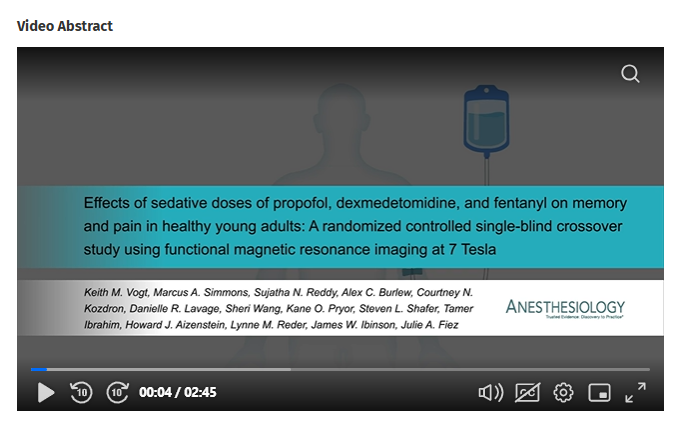
A paper by researchers in our Anesthesiology Neuroscience Research (ANR) program, published in the August 2025 edition of Anesthesiology, was spotlighted in an accompanying editorial and video abstract. It was also featured in the journal’s "This Month in Anesthesiology" headliners list.
“Effects of Sedative Doses of Propofol, Dexmedetomidine, and Fentanyl on Memory and Pain in Healthy Young Adults: A Randomized, Controlled, Single-blind Crossover Study Using Functional Magnetic Resonance Imaging at 7 Tesla” was authored by department members Keith Vogt, MD, PhD, FASA; Marcus Simmons, MD; Alex Burlew, MD; Courtney Kozdron; Dani Lavage, MA; Sheri Wang, MD; and James Ibinson, MD, PhD; along with collaborators from the Departments of Anesthesiology at Weill Cornell Medicine and Stanford University; Carnegie Mellon University’s Department of Psychology; and the University of Pittsburgh Departments of Bioengineering, Neuroscience, Radiology, and Psychiatry. The article explores how three sedative drugs—propofol, dexmedetomidine, and fentanyl—affect memory and pain perception in healthy young adults. The researchers used brain imaging to see how these drugs change brain activity during tasks involving memory and pain. They found that propofol reduced memory performance and brain activity related to memory, while also decreasing pain perception. Dexmedetomidine did not affect memory or pain perception much, but it did lower attention during certain tasks. Fentanyl didn't impact memory significantly but altered brain activity related to pain and attention. These findings help us understand how these drugs work in the brain and might guide future research and anesthesia practices.
The editorial “When Memory Meets Pain: Divergent Neural Signatures of Sedative Agents,” by Zirui Huang, PhD, praised the article for its innovative approach and the depth of insight it provides into how these sedative drugs uniquely affect brain activity related to memory and pain. Dr. Huang highlighted the study's use of advanced neuroimaging techniques to reveal the distinct neural signatures of propofol, dexmedetomidine, and fentanyl during sedation. The editorial commended the research for bridging molecular pharmacology and systems neuroscience and for offering perspective that can guide anesthesia practices toward more tailored and patient-centered approaches.
The full text article, video abstract, and editorial can be viewed on the journal’s website (subscription required):
